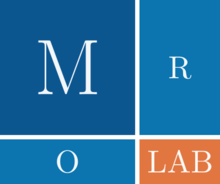m |
|||
| Line 7: | Line 7: | ||
[[file:MORLAB_Logo.png|220px|right|MORLAB Logo]] |
[[file:MORLAB_Logo.png|220px|right|MORLAB Logo]] |
||
| − | [http://www.mpi-magdeburg.mpg.de/projects/morlab MORLAB], the '''M'''odel '''O'''rder '''R'''eduction '''LAB'''oratory toolbox, is a collection of [https://de.mathworks.com/products/matlab.html MATLAB] and [https://www.gnu.org/software/octave/ Octave] routines for model order reduction of |
+ | [http://www.mpi-magdeburg.mpg.de/projects/morlab MORLAB], the '''M'''odel '''O'''rder '''R'''eduction '''LAB'''oratory toolbox, is a collection of [https://de.mathworks.com/products/matlab.html MATLAB] and [https://www.gnu.org/software/octave/ Octave] routines for model order reduction of dynamical systems. The implementation is based on spectral projection methods, like the matrix sign function and the matrix disk function, and on iterative low-rank solvers for large-scale sparse systems. |
| − | The toolbox contains model reduction methods for standard, descriptor and second-order systems based on the solution of matrix equations. |
||
| − | Therefore, also spectral projection based methods for the solution of the corresponding matrix equations are included. |
||
== Features == |
== Features == |
||
The following main features are provided in the latest release of the software (version '''5.0'''): |
The following main features are provided in the latest release of the software (version '''5.0'''): |
||
| − | '''Model reduction methods:''' |
+ | '''Model reduction methods for dense and sparse, first- and second-order, ODE and DAE systems:''' |
| + | * [[Balanced Truncation|Balanced truncation (BT)]] |
||
| − | * for continuous-time standard and descriptor systems ([[Modal truncation|MT]], [[Balanced Truncation|BT]], FLBT, BST, LQGBT, PRBT, BRBT, HINFBT, TLBT, [[Hankel-Norm Approximation|HNA]]) |
||
| − | * |
+ | * [[Modal truncation|Modal truncation (MT)]] |
| + | * Frequency-limited balanced truncation (FLBT) |
||
| − | * for continuous-time second-order systems (SOBT, SOFLBT, SOTLBT) |
||
| + | * Balanced stochastic truncation (BST) |
||
| + | * Linear-quadratic Gaussian balanced truncation (LQGBT) |
||
| + | * Positive-real balanced truncation (PRBT) |
||
| + | * Bounded-real balanced truncation (BRBT) |
||
| + | * H-infinity balanced truncation (HINFBT) |
||
| + | * Time-limited balanced truncation (TLBT) |
||
| + | * [[Hankel-Norm Approximation|Hankel-norm approximation (HNA)]] |
||
| + | * Krylov subspace methods |
||
| + | * Two-step model reduction methods |
||
'''Matrix equation solvers:''' |
'''Matrix equation solvers:''' |
||
| Line 45: | Line 52: | ||
* Official project website: https://www.mpi-magdeburg.mpg.de/projects/morlab |
* Official project website: https://www.mpi-magdeburg.mpg.de/projects/morlab |
||
| − | * Latest upload on Zenodo: https://zenodo.org/record/ |
+ | * Latest upload on Zenodo: https://zenodo.org/record/7072831 |
== Contact == |
== Contact == |
||
Latest revision as of 03:43, 26 September 2023
MORLAB, the Model Order Reduction LABoratory toolbox, is a collection of MATLAB and Octave routines for model order reduction of dynamical systems. The implementation is based on spectral projection methods, like the matrix sign function and the matrix disk function, and on iterative low-rank solvers for large-scale sparse systems.
Features
The following main features are provided in the latest release of the software (version 5.0):
Model reduction methods for dense and sparse, first- and second-order, ODE and DAE systems:
- Balanced truncation (BT)
- Modal truncation (MT)
- Frequency-limited balanced truncation (FLBT)
- Balanced stochastic truncation (BST)
- Linear-quadratic Gaussian balanced truncation (LQGBT)
- Positive-real balanced truncation (PRBT)
- Bounded-real balanced truncation (BRBT)
- H-infinity balanced truncation (HINFBT)
- Time-limited balanced truncation (TLBT)
- Hankel-norm approximation (HNA)
- Krylov subspace methods
- Two-step model reduction methods
Matrix equation solvers:
- Matrix sign function based solvers for continuous-time algebraic Lyapunov, Sylvester, Bernoulli and Riccati equations
- Newton type solvers for continuous-time and discrete-time algebraic Riccati equations
- Smith iteration based solvers for discrete-time algebraic Lyapunov and Sylvester equations
- Structure-preserving doubling based solvers for discrete-time Riccati equations
- Riccati iteration-based solver for continuous-time algebraic Riccati equations with an indefinite quadratic term
Further methods:
- Routines for frequency and time evaluation and visualization
- Routines for the additive decomposition of transfer functions of linear systems
- Partial stabilization of linear systems
- Newton iteration to compute the matrix sign function
- Inverse-free iteration to compute the right matrix pencil disk function
References
- P. Benner, S. W. R. Werner, MORLAB -- A Model Order Reduction Framework in MATLAB and Octave, In A. M. Bigatti, J. Carette, J. H. Davenport, M. Joswig, and T. de Wolff, editors, Mathematical Software -- ICMS 2020, volume 12097 of Lecture Notes in Comput. Sci., pages 432--441. Springer International Publishing, Cham, 2020.
- P. Benner, S. W. R. Werner, Balancing related model reduction with the MORLAB toolbox, Proc. Appl. Math. Mech. 18 (1) (2018) e201800083.
- P. Benner, S. W. R. Werner, Model reduction of descriptor systems with the MORLAB toolbox, IFAC-PapersOnLine 9th Vienna International Conference on Mathematical Modelling MATHMOD 2018, Vienna, Austria, 21--23 February 2018 51 (2) (2018) 547--552.
- P. Benner, S. W. R. Werner, MORLAB - Modellreduktion in MATLAB, in: T. Meurer, F. Woittennek (Eds.), Tagungsband GMA-FA 1.30 ’Modellierung, Identifikation und Simulation in der Automatisierungstechnik’ und GMA-FA 1.40 ’Theoretische Verfahren der Regelungstechnik’, Workshop in Anif, Salzburg, 18.-22.09.2017, 2017, pp. 508--517.
- P. Benner, A MATLAB repository for model reduction based on spectral projection, in: 2006 IEEE Conference on Computer Aided Control System Design, 2006 IEEE International Conference on Control Applications, 2006 IEEE International Symposium on Intelligent Control, 2006, pp. 19--24.
- P. Benner, E. S. Quintana-Ortı́, Model reduction based on spectral projection methods, in: P. Benner, V. Mehrmann, D. Sorensen (Eds.), Dimension Reduction of Large-Scale Systems, Vol. 45 of Lect. Notes Comput. Sci. Eng., Springer, Berlin/Heidelberg, Germany, 2005, pp. 5--45.
Links
- Official project website: https://www.mpi-magdeburg.mpg.de/projects/morlab
- Latest upload on Zenodo: https://zenodo.org/record/7072831

